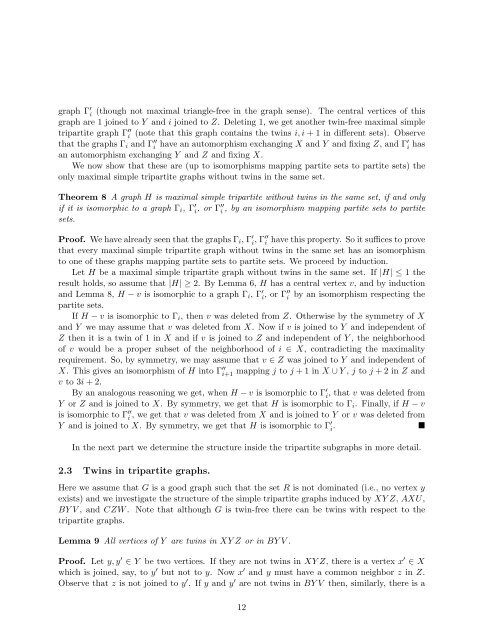Dense triangle-free graphs are four-colorable: A solution to ... - Lirmm
Dense triangle-free graphs are four-colorable: A solution to ... - Lirmm
Dense triangle-free graphs are four-colorable: A solution to ... - Lirmm
You also want an ePaper? Increase the reach of your titles
YUMPU automatically turns print PDFs into web optimized ePapers that Google loves.
graph Γ ′ i (though not maximal <strong>triangle</strong>-<strong>free</strong> in the graph sense). The central vertices of this<br />
graph <strong>are</strong> 1 joined <strong>to</strong> Y and i joined <strong>to</strong> Z. Deleting 1, we get another twin-<strong>free</strong> maximal simple<br />
tripartite graph Γ ′′ (note that this graph contains the twins i, i + 1 in different sets). Observe<br />
i<br />
that the <strong>graphs</strong> Γi and Γ ′′<br />
i have an au<strong>to</strong>morphism exchanging X and Y and fixing Z, and Γ′ i has<br />
an au<strong>to</strong>morphism exchanging Y and Z and fixing X.<br />
We now show that these <strong>are</strong> (up <strong>to</strong> isomorphisms mapping partite sets <strong>to</strong> partite sets) the<br />
only maximal simple tripartite <strong>graphs</strong> without twins in the same set.<br />
Theorem 8 A graph H is maximal simple tripartite without twins in the same set, if and only<br />
if it is isomorphic <strong>to</strong> a graph Γi, Γ ′ i , or Γ′′ i , by an isomorphism mapping partite sets <strong>to</strong> partite<br />
sets.<br />
Proof. We have already seen that the <strong>graphs</strong> Γi, Γ ′ i , Γ′′ i have this property. So it suffices <strong>to</strong> prove<br />
that every maximal simple tripartite graph without twins in the same set has an isomorphism<br />
<strong>to</strong> one of these <strong>graphs</strong> mapping partite sets <strong>to</strong> partite sets. We proceed by induction.<br />
Let H be a maximal simple tripartite graph without twins in the same set. If |H| ≤ 1 the<br />
result holds, so assume that |H| ≥ 2. By Lemma 6, H has a central vertex v, and by induction<br />
and Lemma 8, H − v is isomorphic <strong>to</strong> a graph Γi, Γ ′ i , or Γ′′ i by an isomorphism respecting the<br />
partite sets.<br />
If H − v is isomorphic <strong>to</strong> Γi, then v was deleted from Z. Otherwise by the symmetry of X<br />
and Y we may assume that v was deleted from X. Now if v is joined <strong>to</strong> Y and independent of<br />
Z then it is a twin of 1 in X and if v is joined <strong>to</strong> Z and independent of Y , the neighborhood<br />
of v would be a proper subset of the neighborhood of i ∈ X, contradicting the maximality<br />
requirement. So, by symmetry, we may assume that v ∈ Z was joined <strong>to</strong> Y and independent of<br />
X. This gives an isomorphism of H in<strong>to</strong> Γ ′′<br />
i+1 mapping j <strong>to</strong> j + 1 in X ∪ Y , j <strong>to</strong> j + 2 in Z and<br />
v <strong>to</strong> 3i + 2.<br />
By an analogous reasoning we get, when H − v is isomorphic <strong>to</strong> Γ ′ i , that v was deleted from<br />
Y or Z and is joined <strong>to</strong> X. By symmetry, we get that H is isomorphic <strong>to</strong> Γi. Finally, if H − v<br />
is isomorphic <strong>to</strong> Γ ′′<br />
i , we get that v was deleted from X and is joined <strong>to</strong> Y or v was deleted from<br />
. <br />
Y and is joined <strong>to</strong> X. By symmetry, we get that H is isomorphic <strong>to</strong> Γ ′ i<br />
In the next part we determine the structure inside the tripartite sub<strong>graphs</strong> in more detail.<br />
2.3 Twins in tripartite <strong>graphs</strong>.<br />
Here we assume that G is a good graph such that the set R is not dominated (i.e., no vertex y<br />
exists) and we investigate the structure of the simple tripartite <strong>graphs</strong> induced by XY Z, AXU,<br />
BY V , and CZW . Note that although G is twin-<strong>free</strong> there can be twins with respect <strong>to</strong> the<br />
tripartite <strong>graphs</strong>.<br />
Lemma 9 All vertices of Y <strong>are</strong> twins in XY Z or in BY V .<br />
Proof. Let y, y ′ ∈ Y be two vertices. If they <strong>are</strong> not twins in XY Z, there is a vertex x ′ ∈ X<br />
which is joined, say, <strong>to</strong> y ′ but not <strong>to</strong> y. Now x ′ and y must have a common neighbor z in Z.<br />
Observe that z is not joined <strong>to</strong> y ′ . If y and y ′ <strong>are</strong> not twins in BY V then, similarly, there is a<br />
12

















